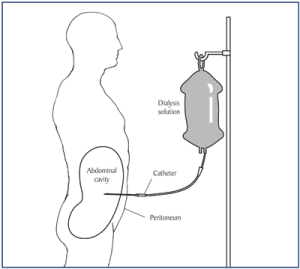Dialysis
Hemodialysis is a process where toxins and fluid are removed from a person's blood by passing the blood through a filter or membrane. This procedure usually lasts approximately 4 hours, and most people require 3 treatments weekly. It can be performed at home or at a designated dialysis facility. It requires a specialized shunt, called an arteriovenous fistula(AVF) or graft(AVG).
Peritoneal Dialysis is a process where a cleansing liquid called dialysis solution or dialysate fills your abdomen and this facilitates the cleaning of toxins & fluids from your body. The walls of your abdominal cavity are lined with a membrane called the peritoneum, which allows waste products and extra fluid to pass from your blood into the dialysis solution. The solution contains a sugar called dextrose that will pull wastes and extra fluid into the abdominal cavity. These wastes and fluid then leave your body when the dialysis solution is drained. The used solution, containing wastes and extra fluid, is then thrown away. The process of draining and filling is called an exchange and takes about 30 to 40 minutes. The period the dialysis solution is in your abdomen is called the dwell time. A typical schedule calls for four exchanges a day, each with a dwell time of 4 to 6 hours. Different types of PD have different schedules of daily exchanges. This type of dialysis is a more flexible and convenient modality and can be performed while sleeping.
Arteriovenous Fistula
An AV fistula is a special shunt created in the arm by connecting an artery directly to a vein. This connection causes more blood to flow into the vein; as a result, the vein grows larger & stronger, making repeated needle insertions for hemodialysis treatments easier. During surgery, you’ll be given a local anesthetic, and the procedure is done usually on an outpatient basis.
Peritoneal Dialysis Catheter
This is a soft tube inserted into your abdomen(see image above) that allows a person to dialyze via the abdominal cavity. Placement of the catheter is an outpatient procedure, and the catheter cannot be seen by casual observers.
Kidney Biopsy
This is an outpatient procedure that may be required to determine the cause of your kidney disease. A small needle is inserted through the lower back to remove a sample of kidney tissue.
Prevention of Kidney Disease
Kidney disease can be mainly prevented by controlling your diabetes & blood pressure. This takes discipline and commitment!!
Kidney Transplant
We refer all patients who are eligible for a kidney transplant to the appropriate transplant center. Transplant is the ultimate treatment of choice for kidney failure, so we are very aggressive about referring patients to the center(s) of their choice. We refer to University Hospital in Jackson, Tulane University in New Orleans, UAB in Birmingham, UT in Memphis, and any other centers where the patient is eligible.




